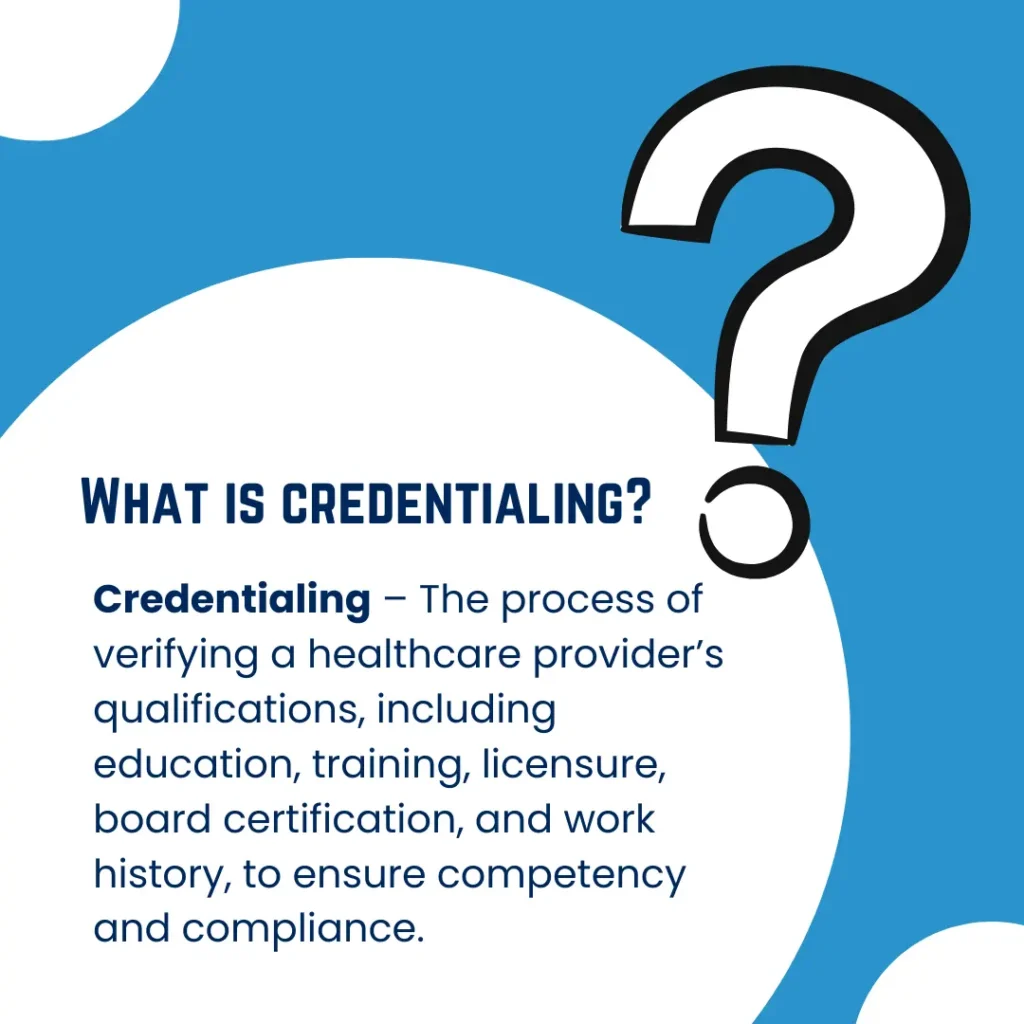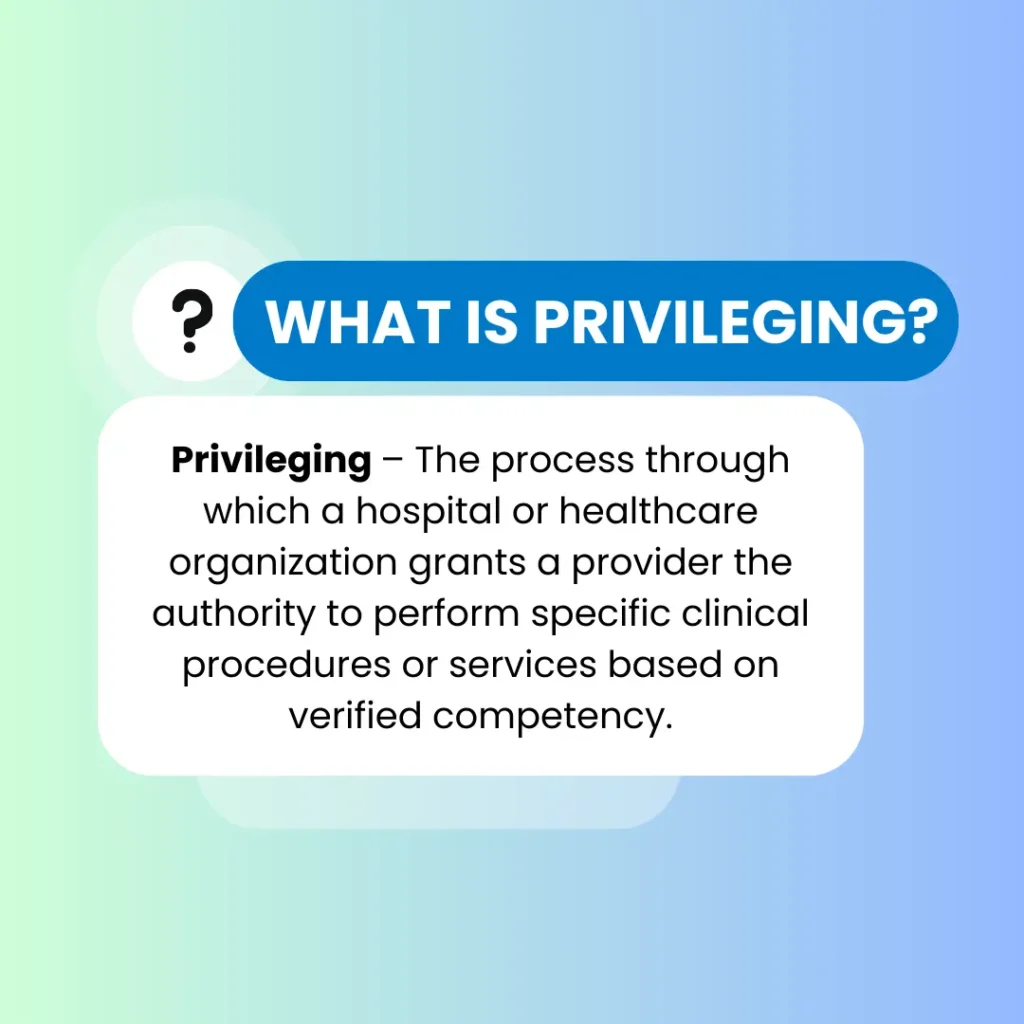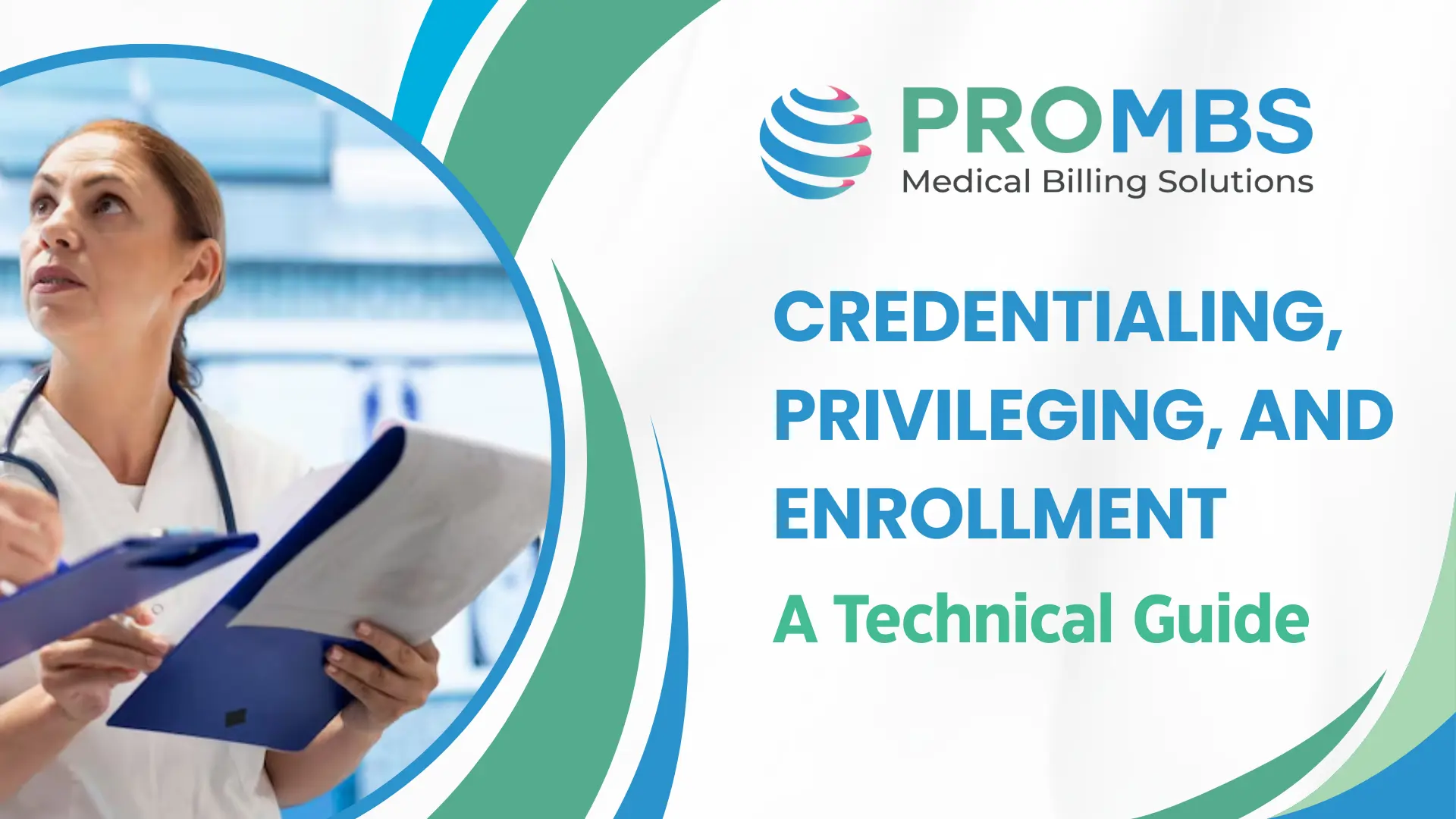Provider enrollment is the structured process through which healthcare professionals gain approval to participate in payer networks and bill for services. Unlike credentialing, which verifies a provider’s qualifications, enrollment focuses on aligning a physician or organization with payer requirements, compliance standards, and reimbursement protocols. A precise and timely enrollment process is essential to avoid claim rejections, delays in payment, and compliance issues with federal and commercial payers. By understanding each stage from strategy to payer approval, organizations can streamline operations and ensure uninterrupted revenue flow.
CREDENTIALING

What Are the Step-by-Step Stages in the Credentialing Process?
Step 1: Application Intake
The process begins with application intake, during which the provider submits a complete application including demographic details, a CV that accounts for all activities with month and year, declared specialties, and practice locations. Any professional gaps longer than 30 to 60 days must be explained. At this stage, the provider is also required to sign attestation statements confirming the accuracy of the information, granting permission for release of records, and disclosing any prior malpractice claims.
Step 2: Primary Source Verification (PSV)
Once the application is received, primary source verification is initiated. This involves confirming the provider’s state medical licenses, DEA registration, and controlled substance permits, along with verification of board certification or eligibility. Education and training are directly validated with medical schools, internship, residency, and fellowship programs. Sanction checks are conducted through OIG’s LEIE, SAM.gov, and state medical boards to ensure the provider has no exclusions or disciplinary actions. The NPDB is queried for malpractice payments or adverse actions. Employment history is confirmed, and any gaps are clarified. Additionally, current competency items such as BLS, ACLS, ATLS, or PALS certifications are verified based on specialty requirements.
Step 3: Quality and Safety Reviews
The next step focuses on quality and safety validation. A malpractice insurance face sheet is reviewed to ensure coverage is active and adequate, and a five-to-ten-year malpractice claims history is obtained from insurers. If the provider maintains inpatient or surgical privileges, hospital affiliations are checked to verify good standing. Peer reference checks are also performed, usually from two or three colleagues who have directly supervised or observed the provider’s clinical work, to confirm both competency and professionalism.
Step 4: Credentialing Committee Review
After PSV and quality checks are complete, the file is forwarded to the credentialing committee or, in some cases, to a credentialing verification organization (CVO). The committee reviews all findings against organizational standards. If there are discrepancies, such as malpractice concerns or incomplete verification, the committee may request additional documents or impose conditions before approval.
Step 5: Decision and Notification
The committee then makes a determination. The provider may be approved, conditionally approved with requirements such as proctoring, or denied if requirements are not met. At this stage, the recredentialing cycle is defined, which typically occurs every 24 to 36 months, and ongoing monitoring requirements are established.
Step 6: Ongoing Monitoring
Credentialing does not end with approval. Ongoing monitoring is performed throughout the provider’s tenure. This includes monthly or quarterly verification of state license status, DEA registration, and exclusion lists such as OIG. Providers are also subject to recredentialing on schedule or earlier if there is a material change, such as the addition of sanctions, malpractice settlements, or gaps in employment.
Who Verifies Credentials?
Credentialing is carried out by multiple entities to maintain compliance with payer, state, and federal requirements:
- Health Plans / Payer Credentialing Departments, often aligned with NCQA standards, ensure providers meet payer requirements for participation.
- Hospitals and Health Systems’ Medical Staff Services, typically aligned with Joint Commission standards, verify credentials for medical staff privileges.
- Credentialing Verification Organizations (CVOs) are sometimes contracted to handle the credentialing process on behalf of payers or health systems.
- Large Groups and MSOs often use in-house credentialing teams and tools such as CAQH ProView to streamline and centralize credentialing efforts.
What Is a Practical Checklist for New Physician Credentialing?
- Government ID; updated CV (month/year, no gaps).
- NPI (Type 1); NPPES profile current.
- State medical license(s); state CDS (if required); DEA.
- Board certification or eligibility letter; ECFMG (if applicable).
- Medical school/residency/fellowship certificates; training program contacts.
- Malpractice COI (limits per payer/facility) + 5–10 year claims history.
- Hospital staff status letter(s) or intent to apply (if inpatient/surgical).
- Life support certifications: BLS/ACLS/ATLS/PALS (as specialty requires).
- Immunizations/TB/fit testing (per facility).
- Three peer references (same specialty; recent, direct observation).
- NPDB self-query not usually required (organizations query directly), but keep disclosures ready.
- Disclosure forms (ownership, sanctions, criminal history).
- CAQH ProView profile complete and attested (within last 120 days).
PRIVILEGING

What Are Hospital Privileges?
Hospital privileges refer to the specific clinical activities and procedures a physician is authorized to perform within a healthcare facility. These are granted after careful review of qualifications, training, and competency to ensure patient safety and quality of care.
1- Core Privileges are the routine activities that are generally expected within a specialty. For example, a general internist may be granted inpatient care responsibilities as part of their standard scope of practice.
2- Special or Expanded Privileges apply to advanced procedures that require evidence of additional training, certification, or procedural volume. Examples include complex interventions such as endoscopic retrograde cholangiopancreatography (ERCP), transcatheter aortic valve replacement (TAVR), or robotic-assisted surgery.
3- Temporary or Emergency Privileges are short-term authorizations granted under specific policies when urgent needs arise, such as during emergencies, disaster response, or when locum tenens physicians are required to provide coverage.
Finally, all privileges are subject to structured oversight, which includes FPPE (Focused Professional Practice Evaluation) during the initial granting phase or when new privileges are added, and OPPE (Ongoing Professional Practice Evaluation) for continuous monitoring of clinical performance.
What Is the Step-by-Step Process of Hospital Privileging?
1. Application & Delineation of Privileges (DOP)
The process begins when a provider completes the application and delineation of privileges form. At this stage, the provider identifies the specific privileges they are requesting and submits supporting documentation such as procedure logs, case volumes, outcomes, and any continuing medical education (CME) relevant to those procedures.
2. PSV & Competency Evidence
Once the application is received, primary source verification (PSV) is performed to confirm the provider’s training, licensure, and board status. Competency evidence is also evaluated, including case logs, preceptorships, and proctoring records. Malpractice history and peer references specifically addressing procedural competence are reviewed to ensure the provider is qualified for the requested privileges.
3. Departmental Review
The next step involves a detailed review by the specialty department chair or a credentials subcommittee. They assess the adequacy of the provider’s training, case numbers, complication rates, and outcomes. Additionally, the hospital ensures that the necessary resources and support are available to safely grant the requested privileges.
4. Credentials Committee → MEC → Governing Board
After departmental review, the application moves sequentially through the credentials committee, medical executive committee (MEC), and finally to the hospital’s governing board. Each body ensures compliance with medical staff bylaws and may impose conditions such as proctoring requirements, case limitations, or mentoring arrangements before final approval.
5. Granting & FPPE
If approved, privileges are granted initially on a contingent basis, subject to a Focused Professional Practice Evaluation (FPPE). During this phase, the provider must successfully complete a defined number of cases or meet specific performance metrics. Once the FPPE is completed and documented, the provider transitions into Ongoing Professional Practice Evaluation (OPPE), which tracks quality and performance at quarterly or semiannual intervals.
6. Reappointment/Reprivileging (typically every 24 months)
Finally, privileging is not permanent. Every 24 months, providers must undergo reappointment and re-privileging. This process involves re-verifying competence, reviewing updated procedure volumes, outcomes, CME, and performance indicators. Based on this review, privileges may be renewed, modified, or revoked as necessary to maintain high standards of patient safety and care.
ENROLLMENT

What Is the Step-by-Step Process of Provider Enrollment?
1. Strategy & Scope
The first step in the enrollment process is to clearly define the strategy and scope. This involves identifying the payers you will participate with, such as Medicare, Medicaid, or commercial insurance. It also requires determining the types of products like HMO, PPO, or Exchange plans, as well as participation models, whether as a participating provider (par), non-participating provider (non-par), employed provider, or through locum coverage.
2. NPI & Entity Setup
Next, providers must ensure their National Provider Identifier (NPI) setup is correct. Individual providers require an NPI Type 1, while groups or facilities need an NPI Type 2. It is also important to verify legal business names, Tax Identification Numbers (TIN/SSN), and taxonomy codes within the National Plan and Provider Enumeration System (NPPES).
3. Medicare (PECOS) & CMS Forms
For Medicare enrollment, providers must complete the appropriate CMS forms, such as CMS-855I for individual providers, CMS-855R for reassignment to a group, CMS-855B for group enrollment, and CMS-588 for EFT setup. They must also ensure EDI and ERA enrollments with the appropriate Medicare Administrative Contractor (MAC). Providers should make a clear decision regarding their participation status (PAR or non-PAR), keeping in mind that retroactive effective date rules vary by MAC and state.
4. Medicaid & State Programs
Enrollment in Medicaid and other state programs requires use of state-specific portals. Providers are often asked to disclose ownership details, undergo background checks, and sometimes pass site visits. Even after approval at the state level, managed Medicaid plans may still require separate enrollment for participation.
5. Commercial Plans
When enrolling with commercial payers, providers must complete and attest their CAQH ProView profile in full. Enrollment is often processed through payer-specific portals or roster submissions. During contracting, providers should carefully review and negotiate fee schedules, including allowables, modifiers, timely filing limits, and termination clauses.
6. Credentialing by the Payer
7. Effective Dates & Notifications
After approval, providers must obtain written confirmation of participation, which includes the effective date, the products they are enrolled in, primary care provider (PCP) panel status if relevant, and facility linkages.
8. EDI/ERA/EFT Enablement
To streamline payments and remittances, providers must complete payer-specific forms for EDI trading partner setup, ERA enrollment, and EFT/ACH transfers (using CMS-588 or equivalent payer forms). Test remittance files should be reviewed to ensure accuracy before going live.
9. Go-Live & Maintenance
Finally, providers must prepare their practice management system by updating payer IDs, taxonomy rules, and pricing structures. Continuous maintenance is crucial, which includes tracking revalidation and re-credentialing cycles typically every five years for Medicare and every two to three years for commercial plans. Additionally, CAQH attestation must remain current within 120 days, and providers must promptly update any changes related to address, ownership, or licensure.
Documents Commonly Required for Enrollment
When completing payer enrollment or credentialing, providers and practices must submit a comprehensive set of documents to verify identity, qualifications, and compliance.
Identity & Numbers are the foundation of enrollment. This typically includes the National Provider Identifier (NPI) Type 1 for individual providers and Type 2 for groups along with official NPPES printouts. For tax purposes, payers require a current IRS W-9 form and, in the case of groups, the IRS TIN assignment letter (CP-575). Additionally, providers must submit a government-issued photo ID and, in some cases, a Social Security number for background checks, depending on state and payer requirements.
Licensure & Authority documents confirm a provider’s legal ability to practice. Active state medical licenses, DEA certificates, and state-specific controlled substance registrations (if applicable) are always required. Board certification or eligibility documentation is often necessary, along with an ECFMG certificate for international medical graduates.
Training & Competence must be demonstrated through copies of diplomas and certificates from medical school, residency, and fellowship programs. A recent, gap-free curriculum vitae (with dates in month/year format) is required. Additionally, providers must maintain current life support certifications such as BLS, ACLS, ATLS, or PALS, depending on their specialty and scope of practice.
Sanctions & Malpractice history is also carefully reviewed. Providers must submit a current malpractice certificate of insurance with coverage that meets payer minimums. Most payers also request a five- to ten-year malpractice claims history (loss runs) directly from insurers. Disclosure forms covering ownership, prior sanctions, or criminal history are mandatory, as payers will also conduct independent checks through NPDB, OIG LEIE, and SAM databases. Having clear disclosures prepared can streamline this process.
Practice & Group Details are equally important. Practices must provide current addresses, phone and fax numbers, business hours, and after-hours coverage arrangements. Organizational documents, such as articles of incorporation or an operating agreement, may also be required for group practices. Some payers request hospital affiliation or privilege letters, particularly for specialties that require hospital-based services. Practices performing laboratory or radiology services may need to submit a CLIA certificate and any facility-specific licenses.
Financial & EDI Setup ensures smooth payments and claims processing. Providers must complete EFT/ACH enrollment forms, such as CMS-588 or the payer’s equivalent, and submit a voided check to establish direct deposit. Electronic remittance advice (ERA) and electronic data interchange (EDI) forms are also commonly required, whether completed through the payer or a clearinghouse. Contact details for both remittance and credentialing must be included.
Finally, Advanced Practice Providers (APPs), such as nurse practitioners or physician assistants, may be required to submit collaborative or supervisory agreements, along with any state-specific protocols governing their practice.
Conclusion
Provider enrollment is not a one-time administrative task but an ongoing compliance-driven process that requires precision, timely updates, and adherence to payer-specific standards. From NPI validation to Medicare PECOS filings, Medicaid site visits, and commercial payer credentialing, each step carries operational and financial impact. Any delays, incomplete documentation, or misalignment with contracting terms can result in denied claims, delayed reimbursement, or even network exclusion. Practices that implement standardized workflows, maintain accurate CAQH attestations, and centralize document management are better positioned to navigate payer complexities efficiently.
Beyond initial approval, continuous monitoring is critical. Revalidation cycles, recredentialing requirements, and change notifications (e.g., address, ownership, or licensure updates) must be proactively managed to ensure uninterrupted participation. Integrating technology tools for enrollment tracking, leveraging credentialing verification organizations (CVOs), and establishing internal compliance audits can significantly reduce administrative burdens while safeguarding revenue integrity. Ultimately, a disciplined and technically sound approach to provider enrollment ensures operational stability, regulatory alignment, and timely reimbursement across all payer channels.



